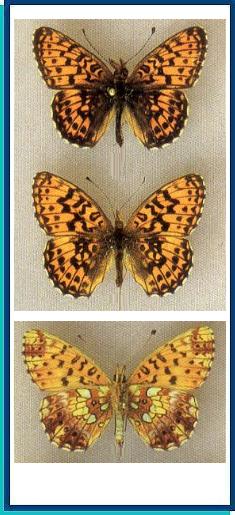LEPIDOPTERA
N Y M P H A L I D A E Swainson, 1827
CLOSSIANA Reuss, 1920
Clossiana selenis (Eversmann, 1837)
Clossiana selenis (Eversmann, 1837)

• TYPE LOCALITY. «Kasan» [Kazan. Republic Tatarstan, Russia].
• RANGE. From Volga River and the S. Urals across Siberia, the Altais, the Sayan and Transbaikalia to the Far East, the Amur and Ussuri regions; Mongolia.
• DISTRIBUTION AND VARIATION. Variability not so great. The nominotypical subspecies is distributed in the Volga Valley and the S. Urals. The Polar Urals and Yamal Peninsula are inhabited by the ssp. samkoi (Sheljuzhko, 1931). Nearly the entire Siberian part of the range, including the Amur region, are populated by the ssp. sibirica (Erschoff, 1870) (= festiva (Krulikovsky, 1893); = meinhardi (Sheljuzhko, 1929)). From NE. Siberia, the ssp. kononovi (Kurentzov, 1970) (= penmovi Korb, 1999) has been described. In the Ussuri region, the ssp. chosensis (Matsumura, 1927) has been found, while Sakhalin Island is known to support the ssp. onorensis (Matsumura, 1925).
• TAXONOMIC NOTES. Based on a single female, Clossiana speranda Grosser. 1979 has been described as a distinct species from NW. Mongolia. According to the original description, this specimen is only distinguishable from C. selenis by the black round spot in the basal part of the discal cell of the UNH, versus yellow with a black surrounding in selenis. Specimens with a similar black spot on the UNH often occur in different parts of the distribution area (Altai, Tuva, Ussuri region). A study of the genitalia of both sexes of such specimens reveals no substantial differences from these of the typical form of C. selenis. Hence the taxon speranda is probably an infrasubspecific morph of C. selenis.
• HABITATS AND BIOLOGY. Steppe and meadow-steppe; in the western part of the area, also wet biotopes; in the mountains up to 2,200 m a.s.l. Flight period: June to August, in one generation; in the Ussuri region with two generations, one in May to June and the other at the end of July to September, with specimens of the second generation lighter in colouration and with a delicate marking on the UPS. Host plants (Korshunov & Gorbunov, 1995): various Viola species.
• SIMILAR SPECIES. Clossiana angarensis, C. oscarus: discal band of UNH without mother-of-pearl spots. C. selene, C. euphrosyne, C. iphigenia, C. perryi: sub-marginal lunules on UNH silvery, postdiscal area on UNH yellow, reddish or brownish.
Photo and text: Guide to the BUTTERFLIES OF RUSSIA and adjacent territories Volume 2. PENSOFT, Sofia - Moscow. 2000